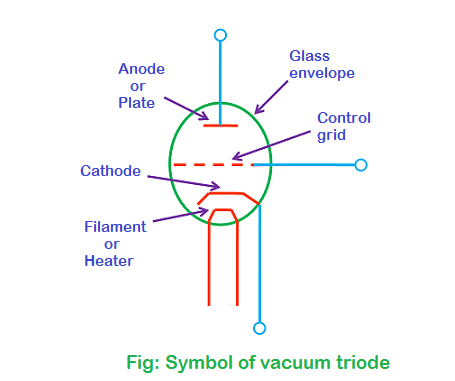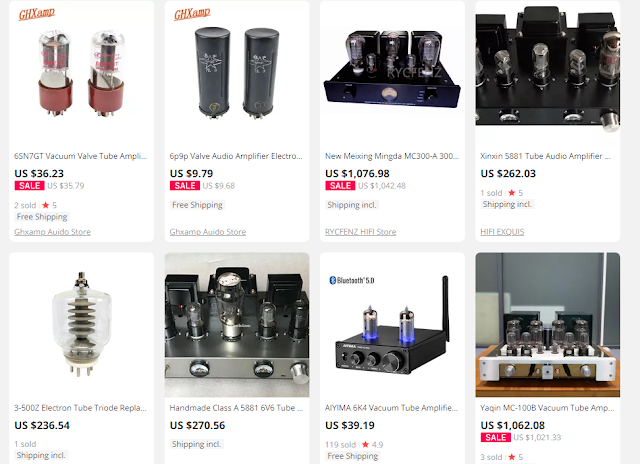Vacuum Triode Amplifier
A vacuum tube triode is an active electronic component that used to be commonly used in amplifiers and other electronic products. I say used to be, because it has generally been replaced by transistors in modern electrons. However, there still remain a few applications where vacuum tube triodes is still used today. One of those applications is in the preamp section of audio amplifiers. Another is in the power amplifier section of audio amplifiers. Triodes are still used in audio equipment these days because they have pleasing distortion characteristics compared to transistors. Triodes and tubes in general are also still used in applications that deal with either very high frequencies or very high power levels, such as radar and other microwave equipment, as well as high power radio transmitters.
Vacuum triode
Vacuum triode consists of three electrodes: anode, cathode and control grid. The anode, cathode and control grid are enclosed in an empty glass envelope. The cathode is surrounded by a control grid, which is in turn surrounded by anode. The construction of vacuum triode is similar to vacuum diode. However, vacuum triode contains an extra electrode (control grid).
Cathode emits the free electrons when it is heated. Hence, cathode is also called as emitter. The process by which cathode emits the free electrons when it is heated is called thermionic emission. Anode collects the free electrons that are emitted by the cathode. Hence, anode or plate is also called as collector.
In between the anode and cathode, control grid is present. Control grid is placed more nearer to the cathode than anode to increase the electric current efficiently. Control grid will control the flow of electrons between the cathode and anode. Hence, control grid is also called as electron controller or electric current controller.
Control grid is made of network of wires that controls the electrons flow between the cathode and anode. The space between the network of wires in the grid is very large. Hence, the free electrons move easily from cathode to anode through the opening of the control grid. Free electrons that are moving from cathode to anode will carry the electric current.
Vacuum Tube Amplifiers - Costly But True Value for Your Money
The triode is just one type of vacuum tube. There are many different types of vacuum tubes, including rectifiers, diodes, tetrodes, pentodes, hexodes, heptodes, and combination tubes that may include multiple unites of the same type of tube or a combination of different types of tube all enclosed in one unit. Triodes may be either signal amplifiers or power amplifiers. Signal amplifiers are used mostly in preamplifiers, while power amplifiers are used in mostly power amplifiers. The difference between the two is that signal triodes amplify voltage, while power amplifiers amplify current.
Vacuum Tube amplifier consists of vacuum tubes which are used to amplify audio, power and other alternating current signals before transistors were invented. This vacuum technology is still used by guitars. This tube amp basically operates on vacuum tube or valves. Audiophiles usually desire these tubes as tube amplifier is considered ideal for home listening as it produces natural and smooth sound.
The Valve tubes in the vacuum amplifier produce even harmonic distortion and the sound produced is very pleasant to the ears as compared to that of transistors. Most musicians around the globe prefer to use such amplifiers because of their high reliability. Also known as Valve amplifiers, they use electronic components called Vacuum Tubes" or "Electronic Valves" for amplification purpose in the circuit and do not use solid state transistors.
A tube amplifier response is different as compared to a transistor amplifier towards the signal level clipping. In case of tube amplifiers, the transition is less abrupt compared to transition amplifier.
It is based on the technology which was invented around early 20th century: the triode. Its major component being a triode provides high-power i.e. distortionless audio amplification. Commonly used vacuum-tube-based amplifier is the Class-A amplifier circuit and are commonly found in guitar amplifiers. This type of amplifier circuit issued where a high fidelity output signal is required.
These tube amplifiers are used by musicians who always want to produce warm sound from guitars or other musical instruments. These are a bit expensive in comparison to other amplifiers reason being quality doesn't come cheap. It is the cost of raw materials in it that is more in number as compared to solid state amp and also the labor required is more. With the result the end product gives sound which is totally the true value to the money spent.
Choosing the right amplifier out of many totally depends on the style of music you want to play. A 15 watt will be enough for use at home. For those who can really spend more can opt for 30, 50 or 100 watt amps in combo or single cabinet configuration. It all depends on the user's choice and requirement.
Their classification depends on the tubes which are used.
• Preamplifiers tubes used mostly in guitar amplifiers
• Power amplifiers tubes have sound and output power limit.
The above information describes the vacuum tube amplifiers in brief, for music lovers there is lot more interesting to know about the same.
Related: Hight Voltage Generator
NOTE:
Floyd Sweet was more than a professional scientist who worked with magnets. He had a passion for magnetism, and for the concept that the entire universe is permeated with a magnetic field. Once he fully retired in the early 1980s, he would have happily spent many hours each day building a device that could tap into the energy of that magnetic field. But Rose fell ill, and was an invalid for the last seven years of her life. This demanded Floyd's attention and forced him to dip into their savings. He also had to cope with his own ill health, including a period of near blindness. Despite these problems, he worked on his device when not preparing meals and tending to his wife's needs.
SWEET'S VACUUM TRIODE AMPLIFIER: DEFYING CONVENTION
For decades, new-energy researchers talked about the possibility of treating a magnet so that its magnetic field would continuously shake or vibrate. On rare occasions, Sweet saw this effect, called self-oscillation, occur in electric transformers. He felt it could be coaxed into doing something useful, such as producing energy. Sweet thought that if he could find the precise way to shake or disturb a magnet's force field, the field would continue to shake by itself. It would be similar to striking a bell a nd having the bell keep on ringing.



Post a Comment